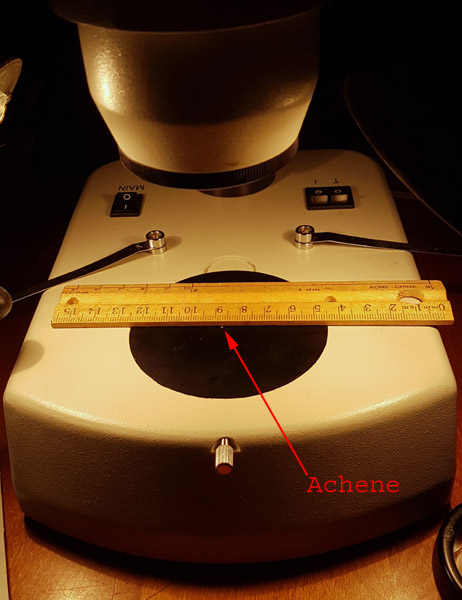 |
Acicularis: Answers
to key questions in Rushes, Bulrushes & Pondweeds plus the remaining
Monocots of Saskatchewan by V. L. Harms, A. L. Leighton, and M. A. Vetter
leading to this species. The answers are in the order you would
normally work through the key.
 |
Plants
perennial, usually mat-forming; rhizomes present; tubercles, when
clearly differentiated, distinctly less wide than achenes. NOT
[Plants annual, with culms densely cespitose; rhizomes absent; tubercles
nearly as wide as achenes.] |
 |
Tubercles
clearly differentiated; achenes rounded distally and distinct from
tubercles; bulbs and tubers absent. NOT [Tubercles not clearly
differentiated; achenes tapering or narrowly truncate distally, often
similar to tubercles in color, texture and form; bulbs or tubers often
present on rhizomes and/or at culm bases.] |
 |
Achenes
with 30 - 60 fine horizontal ridges (trabeculae) and ca. 8 - 12
longitudinal ridges and achene angles, trigonous to nearly terete;
proximal scale of spikelets fertile (subtending flowers, not empty).
NOT [Achenes without fine horizontal ridges, biconvex or trigonous to
nearly terete; proximal scale of spikelets empty.]
|
|
 |
Eleocharis: Answers
to key questions in Rushes, Bulrushes & Pondweeds plus the remaining
Monocots of Saskatchewan by V. L. Harms, A. L. Leighton, and M. A. Vetter
leading to this genus. The
answers are in the order you would normally work through the key.
 |
Flowers
and achenes naked in the axils of scales, not enclosed in a sac; flowers
usually perfect (sometimes some flowers imperfect in Cyperus,
Rhynchospora and Cladium). NOT [Flowers and achenes enclosed in a
sac (perigynium) borne in the axils of scales; flowers imperfect.] |
 |
Perianth
bristles absent or up to 6 per flower; if more than 6, then only
somewhat longer than the achenes. NOT [Perianth bristles usually
more than 10 per flower, much longer than the achenes, conspicuously
elongated to over 10 mm long in fruit stage and usually obscuring most
scales in spikelets.] |
 |
Inflorescence
not a solitary, terminal spike; if solitary, terminal and spike-like,
then inflorescence +/- terete. NOT [Inflorescence a compressed,
solitary, terminal spike bearing few-flowered spikelets attached in 2
rows.] |
 |
Inflorescence
a solitary terminal spikelet; inflorescence bracts absent or up to 8 mm
long and only slightly longer than the spikelet; achenes usually <= 2
mm long (up to 2.3 mm in Eleocharis quinqueflora). NOT
[Inflorescence usually with > 1 spikelet; if only 1 spikelet present,
then inflorescence bract usually 10 - 200 mm long (but as short as 7 mm
in Schoenoplectus subterminalis) and achenes 2 - 3.5 mm long.] |
 |
Leaf
sheaths lacking blades; inflorescence bracts absent (subproximal and
proximal scales, especially those lacking flowers, might be mistaken for
very short bracts); scales 3 - 500 per spikelet; achenes usually bearing
a clearly differentiated tubercle (but see Eleocharis quinqueflora and
E. coloradoensis). NOT [Leaf sheaths with short to long blades;
inflorescence bracts present (may be absent at maturity because
deciduous but will leave a scar) up to 8 mm long and only slightly
longer than spikelets; scales 3 - 20+ per spikelet; achenes lacking a
tubercle but sometimes beaked.]
|
|


